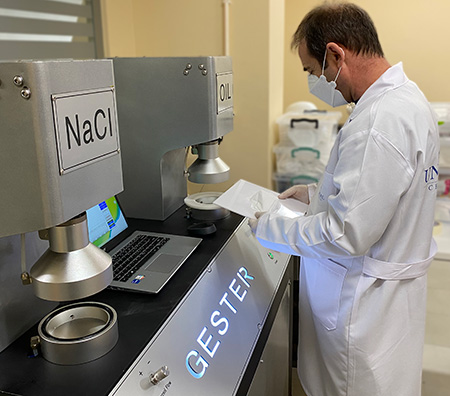Penetration of Filter Material
Respiratory System Protection (MASKS) Tests
In mask tests, some of the samples are tested as received and some are subjected different conditioning (temparature, simulated wearing, mechanical etc.) before getting tested. Necessary explanations are given in the test reports and it is possible to track which sample is subjected to which type of conditioning in each test measurement.
Penetration of Filter Material
It is the test where the mask is tested for its filtering capability with different aerosols. In this test, the filtration efficiency of the mask is measured by using Sodium Cloride and Paraffin Oil aerosols under continuous flow according to European Norms.
The masks designed according to EN 149 standard and widely used in the pandemic period is designed as the whole mask have the filter layer, except the head bands or ear loops and valves if exist. These type of masks are designed to have minimum 3 up to 6 or more layers. One or more of these layers have the filtering capability (commonly meltblown fabrics) and the rest of the layers are installed for keeping the filtering laers from moisture caused by exhalation and other factors those may reduce the filtering capability of the filter layers. In these layers also some fabrics are installed to give a shape to the mask and do not allow the mask to collapse during inhalation.

In these tests, the mask is installed in a sealed manner to the special test setup and the aerosol with the concentration as defined in the standards flow is passed through the mask with the defined flow rate for durations defined in the standards. With special devices the aerosol concentration before the mask and after the mask is measured. This measurement gives the filtration efficiency or in other words the penetration of the filter material of the mask.
The following filtration efficiency limits are given for each performance class in EN 149 standard;
| Class | Maximum allowed penetration of aerosol | |
| Sodium Cloride Test, 95 L/min %, Max |
Paraffin Oil Test, 95 L/min %, Max |
|
| FFP1 | 20 | 20 |
| FFP2 | 6 | 6 |
| FFP3 | 1 | 1 |
For example it is allowed to permit at most 6 pieces of 100 particules for a FFP2 class masks.
The penetration of filter material test is conducted in 3 different steps.
Penetration Test: This is the measurement of particule filtration efficiency of the mask calculated in the last 30 seconds of a 210 seconds duration with the setup explained above. (EN 13274-7 Clause 5.3, 6, 7)
Exposure Test: This is the method for calculating the particule filtration efficiency of the mask with the setup defined above. In this method there is no defined test duration, the test and flow of aerosol continues until 120 mg of test aerosol substance is collected on the mask. (EN 13274-7 Madde 5.4)
Storage Test: This is the test which the particule filtration efficiency is recalculated with penetration test where the masks first subjected to penetration test and exposure tests and stored at room conditions for 24 hours. (EN 13274-7 Clause 5.5)
All the masks shall comply with the given limits for performance class in EN 149 standard.
Notes for Manufacturers: In case of a fail in these tests;
It is recommended for the manufacturers to consider improving the filtering capability of the filtering layer (fabric). Generally the manufacturres either may change the filtering layer (non-woven fabric with electrostatic property, meltblown fabric) with a more efficient one or may change the density or number of layers of the filtering layer to achieve a solution. The performance of some fabrics may change due to the tension or heat of ultrasonic welding or the shelf life of the fabric maybe short. The manufacturers may study these factors and processes to achieve a solution of this situation.
The notes for manufacturers are general considerations and observations of our laboratory and we do not accept any responsibility in case of use of above ideas without a successfull result.
GERİ
